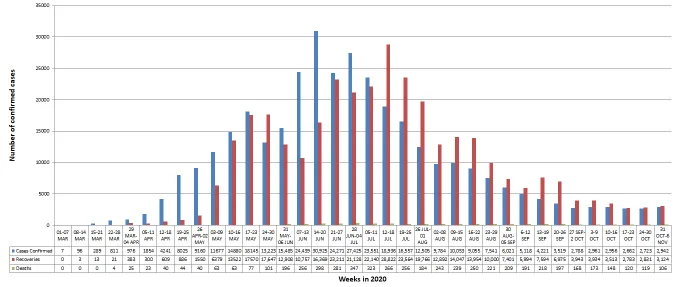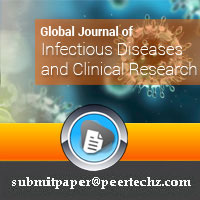Global Journal of Infectious Diseases and Clinical Research
COVID-19 pandemic in Saudi Arabia: The decline continues
Mohammed N Al-Ahdal*
Cite this as
Al-Ahdal MN (2020) COVID-19 pandemic in Saudi Arabia: The decline continues. Glob J Infect Dis Clin Res 6(1): 057-059. DOI: 10.17352/2455-5363.000037The Kingdom of Saudi Arabia is one of the G20 nations and its global influence is arguably undisputed. The country hosts millions of expatriate residents whose mobility has been affected by the COVID-19 pandemic. Although some countries in Asia, Americas, and Europe do not show signs of recuperation or going through a second wave of the disease, Saudi Arabia has been reporting a decline of the infection. The country is starting to open up its borders for exceptional situations, special cases and trade purposes. It is expected that all travelers will be allowed back and forth normally in Saudi Arabia by early next year, including all those visitors for religious purposes and for tourism.
Introduction
COVID-19 has become a global concern due to its health and obvious economic and social consequences on societies world-wide. The World Health Organization (WHO) declared that COVID-19 and its causative virus, SARS-CoV-2, will remain circulating in the world for some time to come. The cases topped 49 million worldwide, with a recovery rate around 71% and a mortality rate of about 2.5% [1]. To date, there are neither curing drugs nor protective vaccines universally and scientifically satisfactory for this infection. However, the more time we go through this infection the more we scientifically know about it and its causative agent, making the world community closer to developing drugs and vaccines. This short article is a record of COVID-19 infection in the Kingdom of Saudi Arabia (KSA) as of 06 November 2020.
The situation in KSA
The population of KSA is 35,000,813 [1]. As of 06 November 2020, confirmed cases in KSA totaled 349,822 (0.99% of population) since the first case was announced on 02 March 2020. Of these RT-PCR confirmed cases, 336,533 (96.2%) recovered and 5,506 (1.6%) died [2]. The rest of PCR-positive cases (n=7,783) were either self-quarantined at their homes or being hospitalized due to shortness of breath and severe illness. This demonstrates that KSA has done well compared to the global COVID-19 situation where some countries remain in the pandemic phase and some are showing a return [3]. Health authorities in KSA had publicized a variety of protective measures, culminating them with a curfew throughout the country at the early phase of the pandemic, closing all borders and suspending all flights and in-country transport [4]. Messages were periodically sent on mobiles and in various languages to citizens and residents to inform them of news and preventive measures. All services were available as home delivery, including food and medicine. Mobile applications for preliminary self-testing, making appointment for screening, talking to physicians, tracing contacts, and notifying those who are in contact with people infected with coronavirus, to name a few, have been available [5-7]. Testing, screening of over 8 million individuals thus far, and hospitalization (if warranted, including being in ICUs) have been available free of charge to all inhabitants. On 16 May 2020, the number of confirmed cases per day reached a peak of 2,840 then it started to recede. On 31 May 2020, a removal of all curfews throughout the country (except in the Holy City of Makkah) was announced to become from 8PM until 6AM next day. It included resumption of domestic flights and inter- and intra-cities travel, re-opening of malls and small shops activities, commencement of office work for all government and private employees, and returning to worship houses. Unfortunately, the cases re-surged to become 4,919 on 17 June 2020 but quickly decreased. On 21 June 2020, all kinds of curfews in KSA were removed and all economic and commercial activities were resumed except for regular international flights and crossing borders. The slogan throughout the country has been “Cautiously We Return.” It seems that after a long period of curfew and the inability for families to be together during festivities, especially religious and cultural holidays, the careless conduct of people was observed. It may be understandable but not necessarily justified. Mass screening also contributed to such a rise of confirmed cases. However, the daily number of recovered cases exceeded the daily number of positive cases starting on 26 May 2020. Currently the number of confirmed cases fluctuates, but the curve is generally descending to a minimum of 323 on 05 and 11 October 2020. Figure 1 depicts the current situation in KSA, reassuring the regression of the epidemiological curve. Until now, inhabitants are strongly encouraged to observe all known and publicized precautionary measures and to remain home unless necessary. All measures taken until 31 May 2020 were described previously [8,9]. Most of the areas and towns known for tourist activities are not of serious concern regarding the COVID-19 pandemic. Tourist visas are not yet issued; however, it is expected that they will be granted in the very near future.
Prevention
When the curfews were completely lifted, there was a surge of confirmed cases, raging to more than 4000 cases per day during the period of 14-19 June 2020. It is believed that such a rise is attributed to the sharp increase in screening and less observance of social distancing. Many directives were issued to warn people of the existence of the virus, most notably the enforced use of masks. There has been a hefty penalty for those who do not comply with wearing masks in public, social distancing or for gatherings of over 50 people at one place. Strong recommendations were given to those in offices and areas with less ventilation and more than one person to continue wearing masks. Aside from trucks carrying food or goods and some emergency or business cases, crossing borders is still prohibited. The Ministry of Health has recently agreed to participate in clinical studies related to the announced Chinese and Russian vaccines [10,11].
The Haj
Haj, or Pilgrimage, to Makkah (the holiest city in Islam) is a yearly religious ritual for Muslims from all over the world. It is a mass gathering, usually encompassing more than 2.5 million people with different cultures and languages, in a small area at a specific time of the year. Because of mass gathering, the Haj period is always considered ideal for dissemination of infectious diseases, especially respiratory. If Haj was broadly allowed as usual, and there was a transmission of SARS-CoV-2, many people may be silently infected and will cause more global spread than the current global rate when they go back to their countries. This year of 2020, the actual Haj performance days were 28 July to 2 August. It was governmentally administered and allowed only for residents of the country. One thousand individuals, with 70% expatriates, were electronically chosen and were 20-60 years-old who are not suffering from any chronic disease. Such conditions were instated in order to minimize any possible SARS-CoV-2 transmission. In addition, wearing masks and social distancing were strictly observed [12]. Certain procedures for COVID-19 prevention were strictly followed. In spite of the fact that returning individuals get some sort of a respiratory illness, there was not a single COVID-19 case recorded among Haj performers during this Haj season of 2020 [13].
Conclusion
Armed with experience from previous epidemics, such as the MERS-CoV epidemic of 2013, the Government and people of the Kingdom of Saudi Arabia have performed an exemplary mission of containing the COVID-19 pandemic. The measures that have been taken, including masking, social distancing, travel restrictions, and various electronic applications, have had a strong impact on limiting the spread of the virus and initial flattening of the epidemiological curve. Saudi Religious and tourism visits are expected to resume as usual during the first quarter of 2021.
I am grateful for the support of the King Faisal Specialist Hospital and Research Center Administration. This article was approved by the institutional Office of Research Affairs.
- Worldmeter (2020) Coronavirus pandemic [Internet]. Link: http://bit.ly/3nPsrAg
- Ministry of Health (2020) COVID-19 Dashboard. Link: http://bit.ly/2J6LCqg
- Algaissi AA, Alharbi NK, Hassanain M, Hashem AM (2020) Preparedness and response to COVID-19 in Saudi Arabia: Building on MERS experience. J Infect Public Health 13: 834-838. Link: http://bit.ly/3peBWcy
- Public Health (2020) New Coronavirus. Link: https://bit.ly/2Wyna4d
- Ministry of Health (2020) COVID-19. Link: http://bit.ly/38rkDhI
- Saudi Data and AI Authority (2020) Tabaud. Link: http://bit.ly/2Kesalc
- Hassounah M, Raheel H, Alhefzi M (2020) Digital response during the COVID-19. pandemic in Saudi Arabia. J Med Internet Res 22: e19338. Link: http://bit.ly/3avZgPe
- Obeid DA, Alhamlan FS, Al-Qahtani AA, Al-Ahdal MN. Containment of COVID-19: the unprecedented response of Saudi Arabia. J Infect Dev Ctries. 2020;14(7):699-706. doi:10.3855/jidc.13203.
- Al-Hanawi MK, Angawi K, Alshareef N, Qattan AM, Helmy HZ, et al. (2020) Knowledge, attitude and practice toward COVID-19 among the public in the Kingdom of Saudi Arabia: A cross-sectional study. Front Public Health 8: 217. Link: http://bit.ly/2KfO1jf
- Arab News (2020) Saudi Arabia working on coronavirus vaccine with Chinese company. Link: http://bit.ly/38ogon9
- Saudi Press Agency (2020) Russia plans to register anti-coronavirus vaccine in 10 days. Link: http://bit.ly/3rdQ2wN
- First Post (2020) Mandatory masks and social distancing: Saudi Arabia's hajj health Measures for domestic pilgrims. Link: http://bit.ly/3avrIR2
- Arab News (2020) Haj season nears end with no COVID-19 at holy sites. Link: http://bit.ly/3nGKJUk
Article Alerts
Subscribe to our articles alerts and stay tuned.
 This work is licensed under a Creative Commons Attribution 4.0 International License.
This work is licensed under a Creative Commons Attribution 4.0 International License.


 Save to Mendeley
Save to Mendeley
